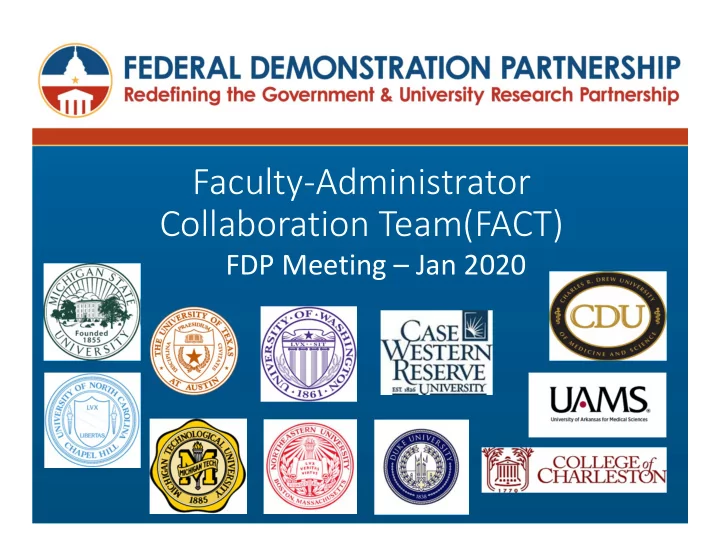

Faculty-Administrator Collaboration Team(FACT) FDP Meeting – Jan 2020
Informing the Future of FACT • Wrap up FACT Phase I • Planned Changes for FACT Phase II • Considerations for FACT Phase II • Align FACT Phase II with FDP Phase VII
Wrap up FACT Phase I FDP is a great opportunity to bring institutional Faculty- Administrator pairs together to: • Gain a better understanding of faculty-administrator operational and strategic interactions • Prioritize key opportunities for analysis and enhancement • Re-think how we collaboratively do the business of research and research administration • Explore diversity and commonality of efforts and goals • Articulate the importance of faculty-administrator collaboration
Phase I Focus on Process Collaborative Stages of University Research Pre-Award Post-Award Collaborate to: Collaborate to: Collaborate to: Collaborate to: Collaborate to: Outcomes & Pre-Submission Submission Receive & Enable Manage & Comply Closure What are the collaborative components within each stage? Who are the stakeholders in each collaborative component? Who is the primary “owner” of each stage?
Phase I Takeaways • FACT works. Faculty and administrators jointly analyzed the grants management process to identify: • Process gaps and pain points • Best practices for research administration • Many business process complexities stem from diverse faculty and research administrators’ roles and goals • There is significant institutional overhead and administrative burden generated outside federal requirements
Phase I Takeaways (2) • Faculty-Administrator and Administrator-Administrator collaboration essential but complex and difficult • Fostering a collaborative culture is as important as SOWs and administrative procedures • FACT analyses and the Faculty Workload Survey can be used jointly to: o Better understand faculty and administrators’ experiences o Identify pain points o Develop best practices and institutional strategies.
Planned Changes for FACT Phase II Phase II Leadership Faculty Chair: Steve Post Professor, Vice Chair for Research Pathology Administrator Chair: Suzanne Alstadt Director Research & Sponsored Programs University of Arkansas for Medical Sciences
Considerations for FACT Phase II FACT integration into the FDP structure FACT integration with other groups participating in FDP Expanding participation of additional FDP institutions and Federal representatives Opportunities for FACT Phase 2 initiatives and activities
Explore FACT integration into the FDP structure • Has been “aligned” with the Faculty committee, there is not an Administrative committee. • Need to minimize scheduling conflicts.
Explore ways to integrate FACT with other groups participating in FDP (e.g., JAD) • Minimize duplication of effort, while maximizing progress • Minimize silo approaches to similar topics/projects • How should joint efforts be identified and managed? • Prioritization between FACT and other groups • Ownership – who drives joint projects? • Consultation – what types of projects would FACT lead?
Explore ways for expanding participation of additional FDP institutions and Federal representatives with FACT • Criteria for membership? • Need to have representation from both Faculty and Administration • What would Federal participation look like (e.g., Federal “pairs”; which agencies, requirements for membership, etc.)? • What “role” would the Federal agencies have in determining and participating in FACT activities?
Explore opportunities for FACT Phase 2 initiatives and activities • Integrate with faculty workload survey • Requirement for institutions to have individual reports • Focus on specific topics (e.g., IRB and IACUC are big issues, but only for the research that involve these types of studies)? • How many institutions are needed to get an adequate representation of the different types of research to be meaningful? • Continue analysis of collaborative research processes • Quantitative metrics across institutions analyzed (accuracy and consistency of metrics; types of institutions; willingness to share metrics). • Qualitative surveys-- collect more across different types of research faculty/administrators? • Type of institution • Type of college • Sr./Jr. • Pre-award/post-award/department/regulatory/compliance/financial • Develop a set of general, bi-directional guidelines supporting FDP faculty-administrator collaboration
Alignment with Phase VII Strategic Plan/Goals The FDP streamlines the entire life cycle of research administration from proposal submission to award close- out. • Goal 1: Demonstrate positive impact on administrative efficiency and effectiveness • Goal 2: Institutionalize evaluation to determine the relevance and impact of FDP • Goal 4: Actively engage community partners– administrator, faculty, and federal representatives • Goal 5: Tell a powerful FDP story to internal and external audiences
Open Discussion… FACT integration into the FDP structure FACT integration with other groups participating in FDP Expanding participation of additional FDP institutions and Federal representatives Opportunities for FACT Phase 2 initiatives and activities
Recommend
More recommend